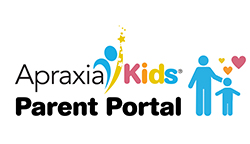There are several types of disorders which cause a child to be difficult to understand, including childhood apraxia of speech, and the treatment for each one is different. One type is an articulation disorder where the child only has a few sounds they are unable to produce correctly (‘r’, ‘s’, and/or ‘z’). In therapy for an articulation disorder, children work on improving each single sound one at a time and generally start with producing the sound in isolation before they work on words with the sound in a specific place in the word (at the beginning of the word). As the child masters the sound at the beginning of words, treatment moves into producing the words in phrases and then sentences and finally in spontaneous speech.
Some children have multiple sounds in error that fall into patterns such as always omitting the final sound in a word or using a consistent substitution such as producing ‘t’ for ‘k’ and ‘d’ for ‘g’. These patterns of errors are called phonological processes and children use them to make words easier to say. A phonological processing disorder is considered to be a language disorder and the therapy approach teaches the child how the incorrect sound pattern changes the meaning of the word (“tan” instead of “can”) and works to produce the correct pattern in words.
Childhood Apraxia of Speech (CAS) is considered a “motor speech disorder”, which means that the child has difficulty planning and programming (in the brain) the quick movements that are needed to speak in a way that can be understood by others. There are many muscles of the face, head, and neck that must move at just the right time, and in the right direction, and with just the right amount of force, so that speech can be understood. This is where CAS therapy should focus. For CAS, sequences of movements from one sound to another within syllables that are needed for speech are worked on. This is why children with CAS need specially designed speech therapy to improve.
Children with CAS need speech therapy that is intensive and addresses all aspects of CAS, is based on the principles of motor learning, and should consider these key ideas:
- In apraxia, the brain has trouble coordinating movement of the articulators (tongue, lips, jaw, palate, vocal cords, diaphragm). The brain must control the timing, speed, direction and tension of all these parts at the same time. For example, a child may struggle to sequence consonant and vowel sounds into a syllable. An older child may have a hard time putting words in the right order. The speech problem can be very complex and/or may change over time. A child’s speech sounds may not develop in the same order as other children’s speech sounds. They may have some sounds they cannot say or not say very many sounds at all. As they start saying more sounds and words, phonological processes may emerge as the child simplifies words because of the difficulty in sequencing the sounds together.
- One of the main features of CAS are problems with prosody (the musicality and stress patterns of spoken language). Prosody is important because it adds meaning and emotion to what we say. Children with other speech disorders do not usually have difficulty with prosody. Children with CAS may improve speech intelligibility, but they sound different because their stress or intonation patterns are unusual. Speech may be slow and choppy or like a robot. Working on prosody is critical part of therapy for a child with CAS.
- Other factors such as rules of grammar and pressure to talk may interfere with speech, too. Pressure is when a child wants to say more than he is able. Performance load is the amount of thinking the brain has to do to speak clearly. The words a child wants to say, the grammar required and the different speech sounds are all a part of the load. A child may not be able to repeat something they just said, especially if it is important. The child may seem to be inconsistent, resistant or even “stubborn”. However, if he could talk, he would. The therapist must consider the performance load of what the child is being asked to say in order build success.
- About fifty percent of children with CAS have trouble with language development. Problems with language may occur when a child is very young or may not happen until they are older. Typically children have more difficulties with expressive language (using words) than with receptive language (understanding). Improving language skills such as vocabulary building and adding grammatical markers such as plurals, past tense and articles must be incorporated into therapy.
- Many children with CAS also display literacy difficulties when they are learning to read. For this reason, pre-literacy skills are incorporated into therapy early on to help prepare the children for reading. Skills include:
- Rhyming (do these words rhyme? “cat” and “hat”)
- Letter-sound association (what does the letter ‘p’ say?)
- Sound identification (what is the first sound in the word “hat”)
- Sound blending (what word is this? “h” “a” “t” – “hat”)
- Sound manipulation (say “cowboy”, now say “cowboy” without “cow”)
Therapy for children with CAS is very specialized and the speech therapist should have training in the above features in order to provide appropriate therapy. The therapy should incorporate the principles of motor learning and be frequent, intensive, and individual one on one sessions initially to help the child establish the motor plans needed for intelligible speech.
Karen Ruehle-Kumar, M.A., CCC-SLP and Stacey Mecham, MSLP, CCC-SLP
December 2021
